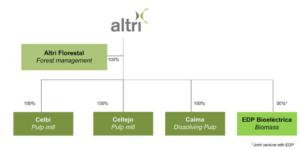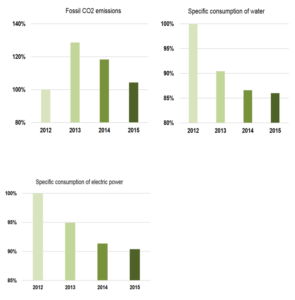Going paperless?

How can companies producing wood pulp expect to remain viable in the long term if its inputs are getting more and more scarce?
Paper! Either for printing or writing, in a school or office environment, we see it everywhere. Worldwide consumption of paper has risen by 400% since 1960 with roughly 1/3 of harvested trees being used to produce paper. More than 400 million tons of paper1 are produced each year.
But if one were to consider all recent advances in technology plus all campaigns promoting a paperless life style, how can it be that production is still increasing? Studies link the underlying reason with cost reduction and affordability. But what is the toll on environment?234:
- Deforestation: c.30-million acres of forest are devastated each year, which results in a 12-17% contribution to annual global greenhouse gas emissions. At the current rate, all rainforests will disappear in less than 100 years
- Water consumption: paper production requires (a lot) of water – an A4 paper sheet uses up to 10 liters
- Energy consumption: The pulp and paper industry is the 5th largest, accounting for 4% of the world’s energy use
- Pollution: from the moment a tree is cut down till the end when it rots or is burned, either methane or carbon dioxide are released in the atmosphere
So what can we do if we cannot stop using paper? Recycling may be a solution. However, while recycling has some benefits, it does not provide a definitive solution simply because paper cannot be recycled indefinitely. Seven to ten times through is about the maximum before the fibers break down3.
In the case of Altri5, a Portuguese industrial conglomerate that operates in wood pulp production, three activities are in place: (i) cultivation of forests for the timber and paper industry, (ii) co-generation of energy, and (iii) waste management (biomass).
As per 2015 annual report6, “(…) strategy implementation is based on integrated forest management (…), ensuring a full recovery of all its components. Thus, the eucalyptus is processed in Altri mills, producing pulp and power (cogeneration). The (…) waste are used to produce electric energy from biomass”.
Since 2013, Altri has dedicated teams working on these issues, namely Altri Florestal and EDP Bioeléctrica (see organizational chart below).
Forest management
Forest management became a key component of Altri in 2010. It manages circa 84,000 hectares of forest, most comply of eucalyptus trees (80% of total area), which implies a self-sufficiency level of c.25%. To reduce transportation costs and oil consumed, the majority of forests are concentrated close to the group’s mills.
Altri is certified by the Forest Stewardship Council (FSC) and by the Programme for the Endorsement of Forest Certification (PEFC), two worldwide acknowledged certification entities. All pulps produced are approved by Nordic Ecolabelling of Paper Products and the European Ecolabel.
A particular feature of Altri is its use of R&D. For trees with lower productivity rates, innovations have been introduced to increase its “yield” over the long term. Nonetheless, in regions where the eucalyptus has failed to succeed, the original flora has been restored.
Cogeneration
Cogeneration is the simultaneous production of heat and power utilising one primary fuel, such as natural gas, oil, wood or wood-waste. These ‘primary’ fuels are used to make electricity, which is known as a ‘secondary’ fuel.
In the case of Altri, the pulp mills burn the black liquor (primary fuel) at the recovery boiler, generating electrical and thermal power that is sold to the grid. Cogeneration represents one of the major investments made by Altri in its recent history, and has recently breakeven, with the excess capacity of electrical power being sold to national electrical company.
Waste management: Biomass
Forest biomass results from tree tops, limbs and cull material left over from logging activity. The forest biomass is burned in a biomass-fire boiler that transfers the heat from combustion into steam that is used to produce electricity.
The use of biomass for energy does not cause an increase in carbon dioxide emissions because as trees and plants grow, they use photosynthesis to remove carbon from the atmosphere. Biomass is a creative way to get rid of waste materials that otherwise would create environmental risks.
Altri is present in the biomass renewable energy business through a joint venture company, EDP Bioeléctica, and produces a total 62 MW of electric power.
In summary, by taking these steps, the company expects to keep the long term sustainability of its business while playing a role in climate change. The impact of these actions are not simple and should provide long term benefits versus the short term investment cost – initial results, as per the pictures below, show significant improvement after 3 years of investment. But if Altri takes the lead, it may set an example for companies in the same industry. (798 words)
[1] Statista, “Production volume of paper and cardboard worldwide 2006 to 2014 (in million metric tons)”. 2016, https://www.statista.com/statistics/270314/production-of-paper-and-cardboard-in-selected-countries/, accessed November 2016
[2] The World Counts, “A useful but wasteful product…”. January 2014, http://www.theworldcounts.com/stories/Environmental_Impact_of_Paper_Production, accessed November 2016
[3] The Paperless Project, “Facts About Paper: The Impact of Consumption”. January 2014, http://www.thepaperlessproject.com/facts-about-paper-the-impact-of-consumption/, accessed November 2016
[4] Judson, D.S., “Paper – The environmental catastrophe”, http://www.infoaktiv.com/assets/Paper%20-%20The%20Environmental%20Catastrophe.pdf, accessed November 2016
[5] Company’s website, https://www.altri.com, accessed November 2016
[6] Company’s 2015 annual report, http://www.altri.pt/~/media/Files/A/Altri-V2/reports-and-presentations/reports/english/2015/ALTRI_2015_AGA_EN.pdf, accessed November 2016







The main problem is not even the printing paper, it’s the packaging industry. Most of the printed media is actually on the decline in the developing world, eg. the newspapers and, increasingly, magazines and books (linked to the advent of Kindle). The developing world is still a printed media stronghold, but this will change too, eventually.
However the cartonboard and the sack paper are unlikely to go away any time soon. From the cereal boxes to shipping carton containers to cement sacks – all of this is made from pulp too, and these sectors (shipping, consumer goods) grow with the GDP. There’s still a tremendous gap in the per capita GDP between the developed and the developing world, and closing this gap will lead to a massive growth in the packaging industry.
Cogeneration is a great opportunity in this industry, however many (probably, most) of the pulp&paper mills globally are still net consumers of electricity because of the inefficient manufacturing schemes of many of the older mills (many of the mills currently in operation were built in the 1960s-1980s). Eg. in Russia there are currently massive CAPEX programs underway at many of the mills to rebalance the production and get them to become net producers.
Very interesting counter-point to paper being the main culprit here!
I recently had the opportunity to visit a Staples fulfillment center that was responsible for receiving, unpacking, re-packaging and shipping items to various Staples.com customers. One of the coolest things I saw during the visit was a machine that would custom make boxes for every single order! In essence, a user’s order would go into the system and the machine would “print” out and cut a precisely sized cardboard box that was custom made to optimally fit all the objects in that order. This box was then labelled for shipping and then sent on a conveyor belt to a bevy of pickers that would then pick and precisely fill the box. This machine eliminated tons of cartonboard and also removed the need for any filler material (usually plastic bags filled with air) since the materials fit inside the boxes perfectly.
I have a bunch of videos that I would love to show you (I can’t post them since it was shot within Staples property) of the kind of innovations fulfillment centers like Staples are undergoing to reduce cartonboard usage.
Interesting post. Like DS, I believe paper is not a culprit but potentially a great raw material that can replace hydrocarbons products, for instance in packaging. It is somehow greener to process lignin and let it rot or burn it than removing hydrocarbons from geological layers and burn it. Personally I am a strong believer than lignin and cellulosis could save us in transitioning smoothly and efficiently away from too much hydrocarbon chemistry. Both Hardwood and Softwood pulp are seeing quite a lot of productivity increase. Brazil production is increasing and could be supported by warmer climate – to a reasonnable extend.
A company such as The Navigator Company does a good job at biomass energy and innovation in woodfree paper. They are also aware of the potential climate change advantage of forestry products… to some extend they are not green for no reason!
But white paper (WFC and UWF) is unlikely to be as green as gray recycled paper from old newspapers or amazon corrugated boxes!